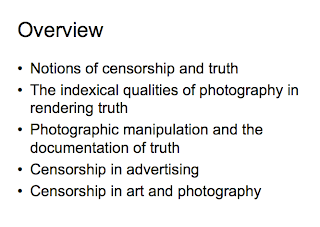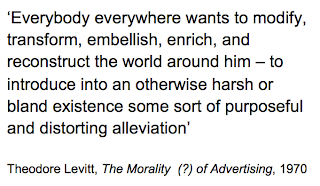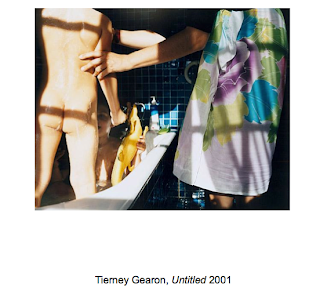the camera never lies
it has lied for a long time
iconic photographs
national park - america
key sight
photographs them over and over again
struggle to explain whats happening with the two photos
hard to see on web based image
same negative over and over - the dark room - exposure of the film changes the photo
different time of day or seasonal or light
can be used to alter things
wasn't really truth at all
Man was removes from photograph because it wasn't appropriate
staling - removed from history
supposed to render truth
the date - 9/11
digital photograph soon after 9/11 - went viral
like adbusters - take the mic
digital technology changing contents
showing her legs - enhanced the lengthen them
is it doing any harm?
does it matter if its true?
is it fair gain in order to sell a product?
news is concerned
the soldier has said the context displayed in this image has changed
you don't no if it was this mix or not
not sure if it's true or not
falling soldier
is it at a point of death?
how much does it matter if it's someone falling or not?
the notion of truth and things being fabricated doesn't just apply to photo
his name isn't Robert Capa - changed his name to a persona when he moved to Paris
made a myth around the name about being famous american photo journalist
fabrication goes as far as the name
how the news is presented to us
appeared in a number of magazines
emotive, poetic, romanticised image
not under the context we think - not in battle
Capa staging a screen of the soldiers running down the hill
is a death of soldier in warzone but not under fire
moves away from basic reality to none at all
writes about photographers and journalists
show the real truth of what was going on
the day the war stopped
irony that the gulf war stopped
non military people were bombed by allie forces
scene that were shown in his photographs
devastation, death and carnage
make love with the war with a condom
very sanitised in the media
reality of it
american soldiers putting bodies in mass graves
all been black and white
classical notion of b/w with history
does it sanitise the image
gruesome - the war that wasn't shown in the media
iconic of truth in the media
'the mile of death' - paper were starting to print in colour
the regulators hit the newspapers for putting this on front page
is it ok for you to be shown it at or breakfast or is it the journalists duty to show us
who's to say what you should and shouldn't see in the news

media event for the west
not really a true image of whats going on in terms of the war
is it more fine are then journalist photography
more landscape than news
doesn't demonstrate
making art
who's to say whats seen as obscene or objectionable?
is it selling your lifestyle better to the reality you've got
climatic music
who's to know they think its fellatio
says more about the individual than whats going on in the advert
is everyone viewing that way or just the individual
sexuality and the catholic church - aids victim
no such thing as bad publicity
reflection of advertising industry
why something as natural as childbirth be more defensive than this

model known for plus size model - suggesting she's in a moment of sexual ecstasy - lay down legs apart and nipple out
was banned

fine art - national gallery
feminist writer on art - 1960s - early voice in feminist voice
writes for the guardian - you can go into national gallery and see a 'masterpiece' but not the opium advert
about syphillcious - promiscuous
venus and cupid - incest scene
we get so worked up about image in advertising yet this incestral scene is a masterpiece properly because its a painting and its how history depicts it
loved or loaved for his work
unclear if there pre pubescent or teen
highly sexualised way

scandal - the girl was the singer of the band - was only 15
was accepted in 1980
reprecating a piece of fine art
would be accepted at all now
highly explicit thing
having sex with his then wife
very kitsch
who's to decide what is serious art and what isn't
around her children

semi eroctic value of it
everyone has naked pictures as children
not blown up and put in books and exhibitions
later on in time - question the appropriateness of the images
images plastered everywhere - online, books, exhibitions
works of her children
is it indecent or is it kids in the bath having fun?
use of the masks
justifying it in that respect - slightly naive with what she's presenting

friends kids doing a dance
magazine of sugar and spice
photographed in a way which is highly sexualised

the tate hung it
the police suggest they take it down
put stickers over the image in the catalogue
her again - invited richard prince to photograph her again as an adult
her mom got a lot of money for the photo of her child
Censorship and ‘Truth”
This lecture considers notions of „truth‟ in the context of Fine Art and the Media, and in particular photography. It will consider the indexical qualities associated with photography and the rendering of „truth‟, which has led to the oft-quoted but flawed cliché that „the camera never lies‟, which has to a large degree been undermined by the possibilities of digital manipulation, however the lecture will show that this is in fact nothing new and has long been possible with analogue (film) photography.
Thus the „truth‟ shown in photography has often been manipulated for a particular purpose, and perhaps most importantly for political propaganda. Within this, it will also consider the versions of the „truth‟ we are allowed to see in the media, i.e. what is kept hidden from us for political reasons.
Jean Baudrillard has considered that in contemporary history, this has gone even further, or almost been reversed to the extent that wars are not as they have been in the past, but are in fact timed and organised in order to be viewed as media events.
Jean Baudrillard and The Gulf War did not take place
“It is a masquerade of Information: branded faces delivered over to the prostitution of the
image” Jean Baudrillard, The Gulf War Did not Take Place, 1995, p.40
„It is the de-intensified state of war, that of the right to war under the green light of the UN and with an abundance of precautions and concessions. It is the bellicose equivalent of safe sex: make war like love with a condom! On the Richter scale, the Gulf War would not even reach two or three. The build up is unreal, as though the fiction of an earthquake were created by manipulating the measuring instruments‟. Jean Baudrillard, The Gulf War Did Not Take Place, 1995, in Poster, M. (ed.) (1988), Jean Baudrillard: Selected Writings, Cambridge, Polity Press, page 233
„Two intense images, two or perhaps three which all concern disfigured forms or costumes which correspond to the masquerade of this war: the CNN journalists with their gas masks in the Jerusalem studios; the drugged and beaten prisoners repenting on the screen of Iraqi TV; and perhaps that seabird covered in oil and pointing its blind eyes to the Gulf sky. It is a masquerade of information: branded faces delivered over to the prostitution of the image, the image of an unintelligible distress. No images of the field of battle, but images of masks, of blind or defeated faces, images of falsification. It is not war taking place over there but the disfiguration of the world‟ Jean Baudrillard, The Gulf War Did Not Take Place, 1995, in Poster, M. (ed.) (1988), Jean Baudrillard: Selected Writings, Cambridge, Polity Press, page 241
„The claim that the Gulf War of 1990 would not take place (1991), followed by the assertion that it did not take place, seems to defy all logic. Such statements are anticipated by the earlier claim (1983) that the only future war would be a hyperreal and dissuasive war in which no events would take place because there was no more space for actual warfare. The underlying argument is that the Gulf War was a simulated war or a reproduction of a war. Whatever its human consequences, this was, for Baudrillard, a war which consisted largely of its self-representation in the real time of media coverage‟ Macey, D. (2000), The Penguin Dictionary of Critical Theory, London, Penguin, page 34
Baudrillard on Simulacra and Simulations
„Abstraction today is no longer that of the map, the double, the mirror or the concept. Simulation is no longer that of a territory, a referential being or a substance. It is the generation by models of a real without origin or relativity: a hyperreal. The territory no longer precedes the map, nor survives it. Henceforth it is the map that precedes the territory – precession of simulacra‟
This lecture considers notions of „truth‟ in the context of Fine Art and the Media, and in particular photography. It will consider the indexical qualities associated with photography and the rendering of „truth‟, which has led to the oft-quoted but flawed cliché that „the camera never lies‟, which has to a large degree been undermined by the possibilities of digital manipulation, however the lecture will show that this is in fact nothing new and has long been possible with analogue (film) photography.
Thus the „truth‟ shown in photography has often been manipulated for a particular purpose, and perhaps most importantly for political propaganda. Within this, it will also consider the versions of the „truth‟ we are allowed to see in the media, i.e. what is kept hidden from us for political reasons.
Jean Baudrillard has considered that in contemporary history, this has gone even further, or almost been reversed to the extent that wars are not as they have been in the past, but are in fact timed and organised in order to be viewed as media events.
Jean Baudrillard and The Gulf War did not take place
“It is a masquerade of Information: branded faces delivered over to the prostitution of the
image” Jean Baudrillard, The Gulf War Did not Take Place, 1995, p.40
„It is the de-intensified state of war, that of the right to war under the green light of the UN and with an abundance of precautions and concessions. It is the bellicose equivalent of safe sex: make war like love with a condom! On the Richter scale, the Gulf War would not even reach two or three. The build up is unreal, as though the fiction of an earthquake were created by manipulating the measuring instruments‟. Jean Baudrillard, The Gulf War Did Not Take Place, 1995, in Poster, M. (ed.) (1988), Jean Baudrillard: Selected Writings, Cambridge, Polity Press, page 233
„Two intense images, two or perhaps three which all concern disfigured forms or costumes which correspond to the masquerade of this war: the CNN journalists with their gas masks in the Jerusalem studios; the drugged and beaten prisoners repenting on the screen of Iraqi TV; and perhaps that seabird covered in oil and pointing its blind eyes to the Gulf sky. It is a masquerade of information: branded faces delivered over to the prostitution of the image, the image of an unintelligible distress. No images of the field of battle, but images of masks, of blind or defeated faces, images of falsification. It is not war taking place over there but the disfiguration of the world‟ Jean Baudrillard, The Gulf War Did Not Take Place, 1995, in Poster, M. (ed.) (1988), Jean Baudrillard: Selected Writings, Cambridge, Polity Press, page 241
„The claim that the Gulf War of 1990 would not take place (1991), followed by the assertion that it did not take place, seems to defy all logic. Such statements are anticipated by the earlier claim (1983) that the only future war would be a hyperreal and dissuasive war in which no events would take place because there was no more space for actual warfare. The underlying argument is that the Gulf War was a simulated war or a reproduction of a war. Whatever its human consequences, this was, for Baudrillard, a war which consisted largely of its self-representation in the real time of media coverage‟ Macey, D. (2000), The Penguin Dictionary of Critical Theory, London, Penguin, page 34
Baudrillard on Simulacra and Simulations
„Abstraction today is no longer that of the map, the double, the mirror or the concept. Simulation is no longer that of a territory, a referential being or a substance. It is the generation by models of a real without origin or relativity: a hyperreal. The territory no longer precedes the map, nor survives it. Henceforth it is the map that precedes the territory – precession of simulacra‟
„Whereas representation tries to absorb simulation by interpreting it as false representation,
simulation envelops the whole edifice of representation as itself a simulacrum. These would
be the succesive phases of the image:
Jean Baudrillard, Simulacra and Simulations, 1981, in Poster, M. (ed.) (1988), Jean Baudrillard: Selected Writings, Cambridge, Polity Press
Censorship in Art
Amy Adler – The Folly of Defining ‘Serious’ Art
Adler is a Professor of Law at New York University and recognises „an irreconcilable conflict
between legal rules and artistic practice‟.
She suggests that the requirement that protected artworks have „serious artistic value‟ is the very thing contemporary art and postmodernism itself attempt to defy
The Miller Test (1973) asks three questions to determine whether a given work should be labelled „obscene‟, and hence denied constitutional protection:
Aronson, E. and Pratkanis, A., 1992, Age of Propaganda: The Everyday Use and Abuse of Persuasion, New York, Henry Holt & Co.
Baudrillard, Simulacra and Simulations, 1981, in Poster, M. (ed.) (1988), Jean Baudrillard: Selected Writings, Cambridge, Polity Press
Jean Baudrillard, The Gulf War Did Not Take Place, 1995, in Poster, M. (ed.) (1988), Jean Baudrillard: Selected Writings, Cambridge, Polity Press Hawthorne C. and Szanto, A. (eds.) (2003) The New Gatekeepers: Emerging Challenges to free expression in the Arts, New York, Columbia University Arts Journalism Program
Naas M. (2010) The Truth in Photography, Edinburgh, Edinburgh University Press
James Beighton, December 2012
-
It is the reflection of a basic reality.
-
It masks and perverts a basic reality.
-
It masks the absence of a basic reality.
-
It bears no relation to any reality whatever : it is its own pure simulacrum.‟
Jean Baudrillard, Simulacra and Simulations, 1981, in Poster, M. (ed.) (1988), Jean Baudrillard: Selected Writings, Cambridge, Polity Press
Censorship in Art
Amy Adler – The Folly of Defining ‘Serious’ Art
Adler is a Professor of Law at New York University and recognises „an irreconcilable conflict
between legal rules and artistic practice‟.
She suggests that the requirement that protected artworks have „serious artistic value‟ is the very thing contemporary art and postmodernism itself attempt to defy
The Miller Test (1973) asks three questions to determine whether a given work should be labelled „obscene‟, and hence denied constitutional protection:
-
Whether „the average person, applying contemporary community standards‟ would
find that the work, taken as a whole, appeals to the prurient interest
-
Whether the work depicts or describes, in a patently offensive way, sexual conduct
-
Whether the work, taken as a whole, lacks serious literary, artistic, political or
scientific value
-
„To protect art whilst prohibiting trash‟
-
„The dividing line between speech and non-speech‟
-
„The dividing line between prison and freedom‟
Aronson, E. and Pratkanis, A., 1992, Age of Propaganda: The Everyday Use and Abuse of Persuasion, New York, Henry Holt & Co.
Baudrillard, Simulacra and Simulations, 1981, in Poster, M. (ed.) (1988), Jean Baudrillard: Selected Writings, Cambridge, Polity Press
Jean Baudrillard, The Gulf War Did Not Take Place, 1995, in Poster, M. (ed.) (1988), Jean Baudrillard: Selected Writings, Cambridge, Polity Press Hawthorne C. and Szanto, A. (eds.) (2003) The New Gatekeepers: Emerging Challenges to free expression in the Arts, New York, Columbia University Arts Journalism Program
Naas M. (2010) The Truth in Photography, Edinburgh, Edinburgh University Press
James Beighton, December 2012
james.beighton@leeds-art.ac.uk










































































No comments:
Post a Comment